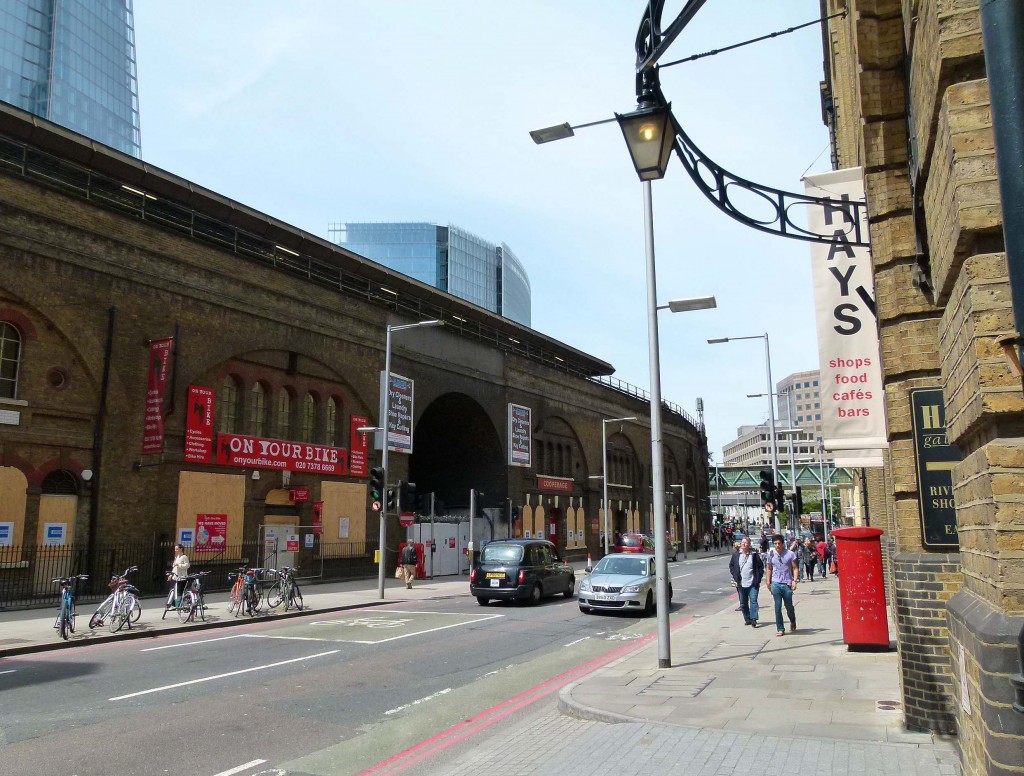Tooley St is a road in Southwark in central and south London that connects London Bridge to St Saviour's Dock, running past Tower Bridge on the Southwark/Bermondsey side of River Thames. It also forms part of the A200 road.
Features of Tooley Street
The road as shown in a 1542 map of Southwark shows only three or four features such as a pillory that had been set up for punishing dishonest traders. Alongside it, the map shows a "cage" that had been installed to house drunken disorderly people who were arrested late in the day and could not be imprisoned at that time. The objective was to keep let them sleep in the confined space of a cage until they became sober. This site for medieval punishments was occupied by the London Dungeon that opened in 1975 proved to be very popular and continued until 2013. It was modelled after the "Chamber of Horrors" in Madame Tussaud's Museum. In 2013, it relocated to County Hall.
Stainer Street which is off Tooley Street and runs under the mainline station has a ‘Blue Plaque' that commemorates those 68 people who were killed in a bombing raid in 1941. The bombing created so much rubble that the bodies of the victims were simply left behind and they were buried in the masonry under London Bridge Station. As part of the London Bridge station redevelopment, Stainer Street has been closed permanently. The area under the Bridge at number 2-4 has now been occupied by a museum and tourist attraction called "The London Bridge Experience and London Tombs". The first part depicts the history of the Bridge and the other part offers entertainment similar to the ‘Dungeon'.

Tooley Street Fire 1861
The fire started on 22 June 1861 in a warehouse at Cotton's Wharf in Tooley Street and continued for two days and in the process it destroyed many nearby buildings. However, it took two weeks for the fire to be extinguished completely and while fighting the fire, the head of the establishment was killed by a falling wall while he was fighting the fire. The fire was one of the largest during the 19th century. At the time of this incident, the insurance companies used to run the London Fire Engine Establishment. After the fire, the premiums were raised by the insurance companies and they threatened to disband the brigade and as such, the government had to take it over and passed the Metropolitan Fire Brigade Act in 1865 to create a publicly funded fire service, which was the first authentic London fire brigade.
Guests staying at Montcalm at the Brewery are located close to most tourist attractions and can avail of luxurious accommodation with plenty of facilities for a comfortable stay in London.
Recent Developments
Tooley Street has acquired two new theatres recently which are the Unicorn Theatre that is part of the More London development that does shows for young people and the Southwark Playhouse that is located in a railway arch behind "The Shipwright's Arms" that had to be relocated to Newington Causeway in 2013 as a result of redevelopment work on the mainline station. Along with the relocation of the London Dungeon from its Tooley Street site, the whole area under the railway arches also came up for redevelopment and as such all establishments on the road were closed including shops, restaurants, bars and even the Britain at War Experience. However, Hayes Galleria was left as it is. You can go there to see David Kemp's ‘The Navigators' which is a great sculpture.
Going along Tooley Street if you keep going east, you can spot the work of Portuguese ceramic artist and illustrator Diogo Machado, also known as ‘Add Fuel to Fire'. If you go a little further you will reach Potters Field that was updated in 2007. It is a little patch of greenery that presents a really pleasant place. If you go to the Tooley Street side of the park, you will be able to appreciate the fretwork screens and the scale model of City Hall.
Before reaching Tower Bridge, you can see two more things that include a grand statue of Samuel Bourne Bevington VD JP, who was a military man but also the first elected Mayor of Bermondsey, for two years from 1900. The areas around Bermondsey and Rotherhithe and a stretch of the riverfront running from London Bridge down to Shad Thames, were part of this particular old borough. The other thing that you can see just to the side of the Colonel is the bust of another local hero, Ernest Bevin, who was a trade unionist and Labour MP of the local area. In Winston Churchill's wartime coalition government, he was Minister of Labour and was responsible for the demobilisation scheme at the end of hostilities. He was then made Foreign Secretary for 6 years in Clement Atlee's Labour government. He was distinguished by his thick West Country accent that confused most Tory MPs at that time.
Contributed by: http://www.themontcalmlondoncity.co.uk/







